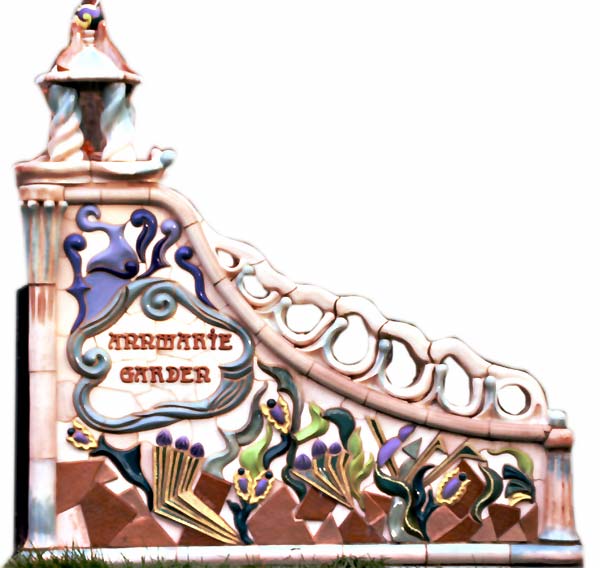|
|
|
||||||||||
|
|||||||||||
|
|||||||||||
|
Walking in a Winter Wonder Land World-class sculptors populate the woods of Calvert County’s Annmarie Garden
Fighting the urge to hibernate, we headed out for an unlikely winter outing: a stroll through Annmarie Garden in Solomons. The drive to the Annmarie Garden, about 55 miles south of Annapolis on Route 2-4, was part of the fun. Leafless branches etched spiky patterns on the sky. Bare branches revealed hidden treasures: vine-covered tobacco barns, horses in pastures and substantial houses and churches, some dating to the 1700s. We were tempted by the parks along the way — Battle Creek Cypress Swamp, Calvert Cliffs State Park and Flag Ponds Nature Park — but we saved them for another day. Just before we reached Solomons, well-placed signs for Annmarie Garden directed us onto Dowell Road. After a stop sign, we drove straight on for less than one-half mile until another sign and two colorful sculptural gates directed us into the garden grounds. The Gateway, as this first sculpture is called, let us know we were in for surprises. Who’d ever seen a ceramic gate? And such a jubilant, theatrical gate in this rustic setting? Another entirely different sculpture surprised us before we parked the car. A Tribute to the Oyster Tonger, A Chesapeake Waterman, by sculptor Antonio Tobias Mendez, is larger-than-life and realistically evokes the hard-working watermen of Chesapeake Bay. The Tonger was the first sculpture installed at Annmarie Garden. Francis Koenig, who with his wife Ann donated the 30 acres on St. John’s Creek to Calvert County for a sculptural park in 1991, asked that the first sculpture be a memorial to the watermen he so admired. Koenig was an architect and developer. He and Ann built a beach house on Long Beach in 1956 and later became avid sailors. They donated the land for the sculptural park in gratitude for the years they had spent on the Western Shore. Annmarie Garden, named for Mrs. Koenig, opened in 1993. Beginning in 2003, a loan program with the Smithsonian Institution has brought contemporary and often surprising sculpture from the Hirshhorn Museum and Sculpture Garden in Washington, D.C. Thus world-class sculptors — including George Rickey, Dame Barbara Hepworth and Francisco Zuniga — populate the woods of Calvert County. “People don’t realize that Babe Ruth is out there in the garden, said events coordinator Melissa Daman, referring to these giants of art. The restrooms, a first stop after the drive, are another unexpected delight, decorated as they are in an improvisational manner with colorful, remnant tiles. Staff and volunteers, assisted by professional tile installers, had free rein to express themselves on the restroom walls artistically. We checked in at the visitor center — to be replaced next spring by a new arts building with indoor exhibit galleries, cafe, gift shop and workshop space for children and adults — to pick up the walking guide that gives detailed information about artists and their sculptures. Other guides — The Toddler Tour, the Artsy Things Scavenger Hunt and the Sculpture Scavenger Hunt — add to the fun for adults and kids. The guides challenged us to figure out which famous paintings are the sources for images painted in miniature on the trees and to find the artists’ signatures on their sculptures. The gallery of the garden is the walking path, a quarter-mile, fully accessible, asphalted trail through the woods. There we succeeded in our scavenger hunt. We found The Spade People, the Algonquin Warrior and the butterflies on the trees. Art is everywhere at Annmarie Garden: on the ground, alongside bushes, on and among trees, highlighted in open spaces — yet carefully spaced so as not to overwhelm, as can happen in an art museum. Walking along the path, we felt like explorers. There always seemed to be something surprising to see. A circle of stones, The Council Ring, calls to mind ancient Native American gatherings. A short path off the main walkway took us down The Women’s Walk where sculptures communicated the artists’ visions of women and the feminine. Stone benches inlaid with tiles, each representing a tree or plant of southern Maryland, are placed along the path. The Paw Paw Bench, the Sassafras Bench, the Loblolly Bench, even the Poison Ivy Bench, reminded us of the beauty of the natural world. These 13 Talking Benches are an artistic collaboration of children in Washington State, students from Mutual Elementary School in St. Leonard and Bainbridge Island artist Maggie Smith. The benches also reminded us that we all can create beauty in art, as these children and artist have done. A gradually rising boardwalk called A Surveyor’s Map, gave us a changing perspective with every step, much like, as the walking guide describes, “the roads, crossroads, zigzags and benchmarks” that make up our memories. Reflections by Calvert County residents are carved into the wood. Just as memories fade with time, these reflections are being slowly worn away by footsteps. The garden that bursts with flowers and foliage in spring, summer and fall, has a special appeal in winter. Towering white pines sway in the wind silhouetted against the sky. Bright green holly trees give bursts of color to the under-story. Massive sculptural forms stand out in bas relief against the bare trees. Annmarie Garden, 13480 Dowell Rd., Dowell. Open daily, 9am-5pm, free: 410-326-4640; |
|||||||||||
|
|||||||||||
|
|
|||||||||||
|
© COPYRIGHT 2008 by New Bay Enterprises, Inc. All rights reserved. |
|||||||||||


 The last few leaves fluttered to frozen ground. Low-lying clouds and a chill in the air portended another gray day in Chesapeake Country.
The last few leaves fluttered to frozen ground. Low-lying clouds and a chill in the air portended another gray day in Chesapeake Country.